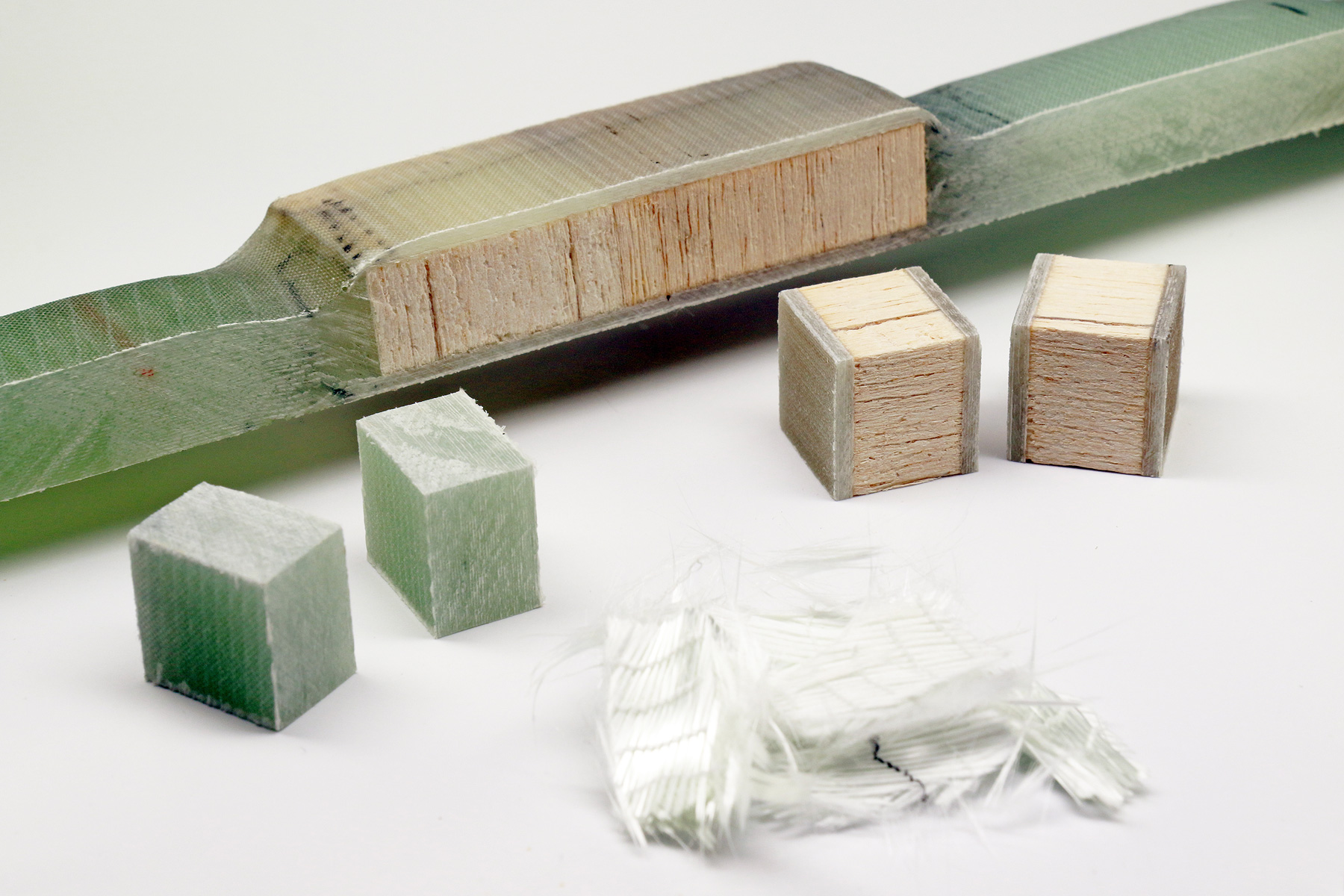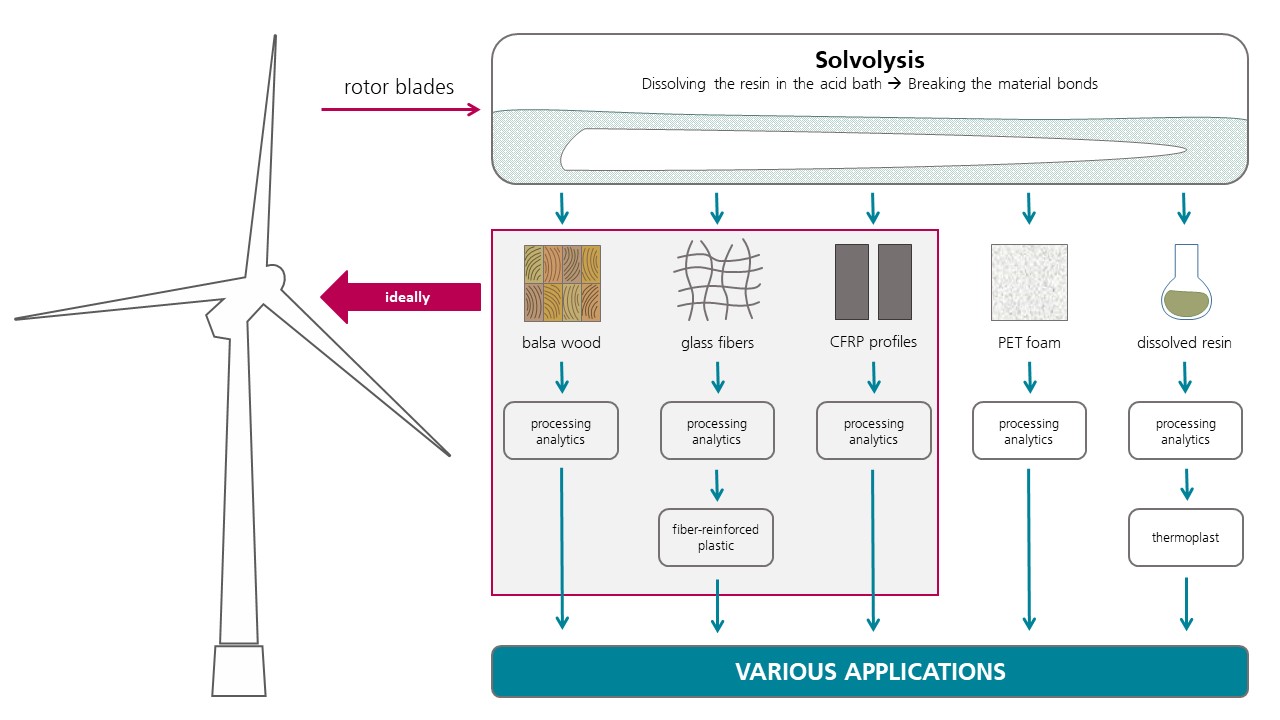ReusaBlade:
Recyclable wind-turbine rotor blades by means of detachable resin systems and reutilization of the recyclate material segregated by type
There are already more than 30,000 wind turbines in Germany. By 2030, there could be more than twice as many. A wind turbine is usable for around 20 to 30 years and must then be disposed of. The tower made from steel and concrete is already very easy to recycle, but the rotor blades have not been up until now. They consist of complex multi-material composites – firmly bonded by thermoset resins. One promising approach: With the aid of detachable resin systems, rotor blades could be constructed in such a way that the materials can be separated by type at the end of the service life. In collaboration with research and industry partners, we are developing industrially feasible production, separation and processing procedures for this purpose. The focus of the Fraunhofer WKI lies in the processing and reutilization of recovered glass fibers and balsa-wood components. As a result, we are helping to ensure that a high-quality reutilization of 100 percent of the wind-turbine materials is possible at the end of their service life.

In wind turbines that have already been erected, the rotor blades are made of fiber-reinforced plastics with thermoset, non-detachable resin systems. For these blades, suitable recycling processes must be developed. Numerous research projects are therefore already in progress or are currently being implemented.
The “ReusaBlade” project, in contrast, is focusing on recycling paths for rotor blades that will be built in the coming years. With the aid of new, detachable epoxy resins, material-separation strategies are to be developed and tested in order to enable a multiple reutilization of rotor-blade materials. As a result, the high-quality recycling of rotor blades should become simpler, more energy-efficient and more economical in the future.

Recovery of the material components of the rotor blades
- Sample production and combination of various materials for the production of a rotor-blade transition segment
- Laminates made from glass-fiber-reinforced plastic (GRP)
- Molded sandwich panels (surface layer made from GRP laminate, core made from PET foam and balsa wood)
- Integration of a main belt made from prefabricated carbon-fiber-reinforced plastic profiles, produced using the pultrusion process (pultruded CFRP)
- Tests regarding the dissolution of the fiber-matrix bond by means of solvolysis at the material level (coupons) and component level
- Tests regarding the handling of the recovered materials (recyclates) and quality testing (glass fibers, balsa wood, PET foam, pultruded CFRP)
- Tests regarding the optimization of recyclate quality at a simultaneously high material throughput through adaptation of the solvolysis process parameters
- Tests regarding the usability of the solvolysis liquid (acid) and the epoxy resin dissolved therein
Reutilization of recovered fiberglass mats and core materials in applications with lower mechanical requirements
- Testing and processing of the recovered fiberglass mats and core materials (balsa wood, PET foam)
- Sample production, testing and modeling of new laminate and sandwich materials made from the recovered materials and new resin at the coupon level
Fiber-reinforced plastics with glass-fiber recyclates:
The recovered fiberglass mats are potentially suitable for the manufacture of fiber-reinforced plastics for applications with lower strength requirements. Examples include:
- Non-load-bearing components in the production of wind-turbine rotor blades, such as lightning-rod mounts, or the partition wall in the hub area of the blade (“bulkhead”) that is necessary for maintenance and occupational-safety reasons on large rotor blades
- Constructions in boat-building
Balsa-wood recyclate:
The recyclability of the recovered balsa wood depends, firstly, on whether the resin between the balsa blocks also dissolves during the solvolysis process or whether this bonding of the blocks is retained. The second decisive factor is the extent to which the wood constituents (lignin, hemicellulose, cellulose) are degraded by the solvolysis process. Depending on the balsa-wood recyclates that can be attained, various new products can be manufactured through processing and further refinement steps. The following would, for example, be conceivable:
- Reutilization as core material in rotor blades
- Lightweight-construction sandwich elements, such as for building elements, vehicle components, surfboards/stand-up paddleboards, etc.
- Wood-based materials for lightweight construction
- Transparent wood
- Highly compacted wood that achieves high strengths without the addition of adhesives
PET-foam recyclate:
The recovered PET-foam elements could be processed both mechanically and chemically and transformed into new products. Both methods are being investigated in the project.
Reutilization of pultruded CFRP profiles as components subject to high structural loads
The CFRP profiles prefabricated using the pultrusion process are detached from the overall material composite (rotor-blade component) by means of the solvolysis process. The fiber-matrix bond within the profiles is, however, thereby retained due to the fact that the CFRP profiles are manufactured using non-detachable resins. Despite the high fatigue loading caused by the operation of the rotor blades, the profiles nevertheless exhibit high residual strengths. This makes them particularly attractive for reutilization.
- Processing of the recovered CFRP profiles (in particular surface modification)
- Production and testing of double-lap shear-test components for evaluation of the mechanical performance capabilities
In the ideal case, the CFRP profiles can be reused for rotor-blade production. Alternatively, other fields of application can be considered.
Industrial feasibility study | Up-scaling
Within the framework of the project, a comprehensive analysis and evaluation of the developed recycling processes is being conducted.
- Cost analysis of treatment processes for the rotor-blade elements with regard to personnel deployment, logistics, energy demand, chemicals disposal, occupational safety, etc.
- Process-parameter studies for the dissolution and recovery of the resin
- Life cycle analysis (LCA) for the differing treatments of the PET foam
- Determination of total process costs
On this basis, recommendations for action regarding the implementation of the recycling process chain on an industrial scale can be proposed.
Last modified:
 Fraunhofer Institute for Wood Research
Fraunhofer Institute for Wood Research 
